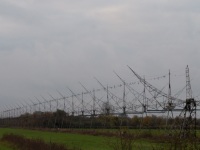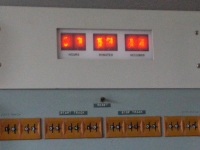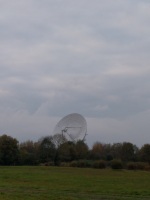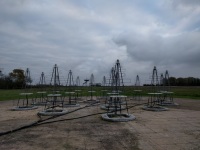Visiting Lord's Bridge
Nov. 5th, 2017 02:23 pmCut because this is quite long.
As part of my PhD induction, I got to go to Lord's Bridge with a bunch of other first year students, to give us a sense of the history (and present) of the Astrophysics group. I've visited before, around 3.5 years ago, but I didn't have a camera last time; plus I wanted to see some of the things that have gone up at Lord's Bridge since I was last there.
This "history" I'm referring to is the history of the Cambridge Astrophysics group. I owe a lot of the information in this blog post to Malcolm Longair, Richard Hills, and Pete Doherty (Chief Technician). The Astrophysics group grew up after the Second World War, using the radar technologies and computing technologies developed during the war to do some new science with them. (Sometimes this was very literal - the group reused the Würzburg dishes that were captured during the war.) They started off using a rifle range not far from the old Cavendish lab in the city centre.
However, they ran out of room there, and managed to get hold of a former MoD piece of land near Lord's Bridge, then still an active railway station. This was land used primarily as an ammo dump during the war. You can see this in the actual landscape - there are lots of earth barriers a couple of metres tall. These were used to separate the ammo stocks, so that an accident wouldn't blow the whole lot up. Some of these features have been used to help shield telescopes from noisy, noisy people. Incidentally, there would have been quite a few women on site - they played a key role in ammunition delivery. Because the site held such delightful things as mustard gas shells (held so that if the Nazis used gas weapons, the British could retaliate promptly...), there were decontamination showers available. Two of them, of course; one for men, one for women.
The money to buy the land and build some nice telescopes on it came from the Mullard company (they manufactured valves), and the MRAO (Mullard Radio Astronomy Observatory) was born. One of the first things they built was the 4C Array - a low-frequency telescope: (click pictures to embiggen)
Only part of the array survives - the North-South portion was dismantled. (And even the East-West bit that survives doesn't have the wires attached any more.) It was one of the first large aperture synthesis telescopes built; now, quite a large proportion of radio telescopes are aperture synthesis telescopes.
Radio telescopes look at different frequencies, so having built one telescope to look at low frequencies, the group built another one to look at some higher frequencies: theOne Mile Telescope. This was the first telescope to use Earth-rotation aperture synthesis, allowing for massive increases in the resolution achieved by radio telescopes. It was also reliant on using extremely up-to-date computing, to compute the Fourier Transforms needed to do data analysis. The Titan computer was part of this early synergy between high performance computing and physics.
The control room for the One Mile looks pretty much like it should be in Doctor Who, Space:1999 or indeed any sci-fi series made between about 1950 and 1985: panels, dials, switches, and stuff.



Really, there should be people in white coats carefully watching the dials, ready to scream things like "she's gonna blow!". There are some panels with chart paper still in them, because that's how the data was first collected, and you could do some debugging by just watching the traces.
This telescope was built on land acquired after Lord's Bridge was Beechinged - fortunately, the railway line ran east-west, which was very useful for building these earth-rotation aperture synthesis telescopes. (The Half-Mile Telescope was built using some of the same infrastructure as the One Mile, to look at slightly different frequencies again.) Both telescopes used track taken from the railway and relaid to let some of thedamn great dishes run along them (some of the dishes were in fixed locations, but others were moveable, to give different baselines*). (The tracks are slightly built up along their length, to account for the curvature of the earth, so that the antennas remain in a plane with one another.)
* A baseline is formed from a pair of antennas. Baselines are very important for interferometers. Wikipedia will give you a guide to this, though it's fairly tough to follow.
Not content with observing lots of radio sources and rather skewering the Steady State theory, Dame Jocelyn Bell Burnell used the Interplanetary Scintillation Array to discover pulsars.
This rather unimpressive field with poles in was a telescope designed to be very sensitive in the time domain (i.e. it could see things changing very quickly). Pulsars do indeed pulse quickly, and hence were picked up using this telescope. It had more wire in it back then, so you could detect signals, and rather fewer bushes, and quite a lot more sheep. (Sheep from the Vet school were used, because it was tricky to get a lawnmower around what with all the poles and wires, and goats would have eaten the telescope too.) While this telescope and that discovery helped win the Group the Nobel Prize, Dame Jocelyn was not included. However, her contribution is definitely not forgotten by the group.
Later came the Ryle Telescope, also known as the 5km Array. (You'll notice that astronomers have really original names for their telescopes. At least the ones named after an actual size don't have the same escalation problems as do those who go for things like the Very Large Telescope, the Extremely Large Telescope etc.) This had an even more impressive control room (which sadly we didn't see this trip, so I have no photos). It had a viewing gallery, so bigwigs could come and see the telescope in operation! The Ryle was taken out of its 5km configuration, and put into a more compact arrangement, and is now the AMI Large Array, and is in use still doing actual science.

Lord's Bridge is part legacy, part working observatory, and part test-bed. I've shown pictures of many of the previous projects, but not all. The Cosmic Anisotropy Telescope (now in Tenerife) was developed in Cambridge (hidden in the remains of one of the ammo dumps - the earth walls were used to shield the telescope from the interference of the city). COAST, the first optical interferometer (again, sorry, I didn't manage to get any reasonable pics), was developed here, and people in the group are working on the next generation of optical interferometers.
One of the working telescopes is eMerlin:

Well, technically, this is only a part of the working telescope - there are other bits scattered around the country, including bits at Jodrell Bank. This is a 30m dish, so it's quite large, but you can't easily get up close, so it's hard to tell how big it really is. In this picture, it's probably looking at Galactic Centre (eMerlin spends quite a lot of time looking in that direction).
The other working telescope is AMI, the Arcminute Microkelvin Imager. AMI uses the Sunyaev Zel'dovich effect to probe the early Universe. There are two arrays: the Large Array (seen above), and the Small Array:

The Large Array is observing bright objects in the field observed by the Small Array, allowing foreground subtraction to do its magic and allow us to observe the subtle effects in the background.
As well as working telescopes, we also run tests on equipment for future telescopes, as we're involved in designing these things. HERA is a telescope to look at the Epoch of Reionisation (i.e. the fairly early universe). The picture below shows some HERA dishes and feeds set up, to test how they all work together, so we can take measurements to do modelling on how the whole array will work when it's done. (It's under construction in South Africa at the moment.) When digging the holes to put the posts up, they found a lot of shell casings and so on - relics of the site's use during the war.

As some of you may know, I've been working on the SKA for the last few years. It was really nice to get out and see this test station:

Although I work on a different bit of the SKA, it's very pleasing to see some things being built, even if they're only a test!
This "history" I'm referring to is the history of the Cambridge Astrophysics group. I owe a lot of the information in this blog post to Malcolm Longair, Richard Hills, and Pete Doherty (Chief Technician). The Astrophysics group grew up after the Second World War, using the radar technologies and computing technologies developed during the war to do some new science with them. (Sometimes this was very literal - the group reused the Würzburg dishes that were captured during the war.) They started off using a rifle range not far from the old Cavendish lab in the city centre.
However, they ran out of room there, and managed to get hold of a former MoD piece of land near Lord's Bridge, then still an active railway station. This was land used primarily as an ammo dump during the war. You can see this in the actual landscape - there are lots of earth barriers a couple of metres tall. These were used to separate the ammo stocks, so that an accident wouldn't blow the whole lot up. Some of these features have been used to help shield telescopes from noisy, noisy people. Incidentally, there would have been quite a few women on site - they played a key role in ammunition delivery. Because the site held such delightful things as mustard gas shells (held so that if the Nazis used gas weapons, the British could retaliate promptly...), there were decontamination showers available. Two of them, of course; one for men, one for women.
The money to buy the land and build some nice telescopes on it came from the Mullard company (they manufactured valves), and the MRAO (Mullard Radio Astronomy Observatory) was born. One of the first things they built was the 4C Array - a low-frequency telescope: (click pictures to embiggen)

Only part of the array survives - the North-South portion was dismantled. (And even the East-West bit that survives doesn't have the wires attached any more.) It was one of the first large aperture synthesis telescopes built; now, quite a large proportion of radio telescopes are aperture synthesis telescopes.
Radio telescopes look at different frequencies, so having built one telescope to look at low frequencies, the group built another one to look at some higher frequencies: theOne Mile Telescope. This was the first telescope to use Earth-rotation aperture synthesis, allowing for massive increases in the resolution achieved by radio telescopes. It was also reliant on using extremely up-to-date computing, to compute the Fourier Transforms needed to do data analysis. The Titan computer was part of this early synergy between high performance computing and physics.
The control room for the One Mile looks pretty much like it should be in Doctor Who, Space:1999 or indeed any sci-fi series made between about 1950 and 1985: panels, dials, switches, and stuff.




Really, there should be people in white coats carefully watching the dials, ready to scream things like "she's gonna blow!". There are some panels with chart paper still in them, because that's how the data was first collected, and you could do some debugging by just watching the traces.
This telescope was built on land acquired after Lord's Bridge was Beechinged - fortunately, the railway line ran east-west, which was very useful for building these earth-rotation aperture synthesis telescopes. (The Half-Mile Telescope was built using some of the same infrastructure as the One Mile, to look at slightly different frequencies again.) Both telescopes used track taken from the railway and relaid to let some of thedamn great dishes run along them (some of the dishes were in fixed locations, but others were moveable, to give different baselines*). (The tracks are slightly built up along their length, to account for the curvature of the earth, so that the antennas remain in a plane with one another.)
* A baseline is formed from a pair of antennas. Baselines are very important for interferometers. Wikipedia will give you a guide to this, though it's fairly tough to follow.
Not content with observing lots of radio sources and rather skewering the Steady State theory, Dame Jocelyn Bell Burnell used the Interplanetary Scintillation Array to discover pulsars.

This rather unimpressive field with poles in was a telescope designed to be very sensitive in the time domain (i.e. it could see things changing very quickly). Pulsars do indeed pulse quickly, and hence were picked up using this telescope. It had more wire in it back then, so you could detect signals, and rather fewer bushes, and quite a lot more sheep. (Sheep from the Vet school were used, because it was tricky to get a lawnmower around what with all the poles and wires, and goats would have eaten the telescope too.) While this telescope and that discovery helped win the Group the Nobel Prize, Dame Jocelyn was not included. However, her contribution is definitely not forgotten by the group.
Later came the Ryle Telescope, also known as the 5km Array. (You'll notice that astronomers have really original names for their telescopes. At least the ones named after an actual size don't have the same escalation problems as do those who go for things like the Very Large Telescope, the Extremely Large Telescope etc.) This had an even more impressive control room (which sadly we didn't see this trip, so I have no photos). It had a viewing gallery, so bigwigs could come and see the telescope in operation! The Ryle was taken out of its 5km configuration, and put into a more compact arrangement, and is now the AMI Large Array, and is in use still doing actual science.

Lord's Bridge is part legacy, part working observatory, and part test-bed. I've shown pictures of many of the previous projects, but not all. The Cosmic Anisotropy Telescope (now in Tenerife) was developed in Cambridge (hidden in the remains of one of the ammo dumps - the earth walls were used to shield the telescope from the interference of the city). COAST, the first optical interferometer (again, sorry, I didn't manage to get any reasonable pics), was developed here, and people in the group are working on the next generation of optical interferometers.
One of the working telescopes is eMerlin:

Well, technically, this is only a part of the working telescope - there are other bits scattered around the country, including bits at Jodrell Bank. This is a 30m dish, so it's quite large, but you can't easily get up close, so it's hard to tell how big it really is. In this picture, it's probably looking at Galactic Centre (eMerlin spends quite a lot of time looking in that direction).
The other working telescope is AMI, the Arcminute Microkelvin Imager. AMI uses the Sunyaev Zel'dovich effect to probe the early Universe. There are two arrays: the Large Array (seen above), and the Small Array:

The Large Array is observing bright objects in the field observed by the Small Array, allowing foreground subtraction to do its magic and allow us to observe the subtle effects in the background.
As well as working telescopes, we also run tests on equipment for future telescopes, as we're involved in designing these things. HERA is a telescope to look at the Epoch of Reionisation (i.e. the fairly early universe). The picture below shows some HERA dishes and feeds set up, to test how they all work together, so we can take measurements to do modelling on how the whole array will work when it's done. (It's under construction in South Africa at the moment.) When digging the holes to put the posts up, they found a lot of shell casings and so on - relics of the site's use during the war.

As some of you may know, I've been working on the SKA for the last few years. It was really nice to get out and see this test station:

Although I work on a different bit of the SKA, it's very pleasing to see some things being built, even if they're only a test!